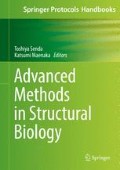Abstract
Analytical ultracentrifugation (AUC) is a very useful technique to characterize macromolecular interactions. In AUC, a centrifugal force of up to about 250,000 g is applied to a solution of macromolecules, and the progression of sedimentation over time is monitored using an optical detection system. Significant advances in both hardware and software over the past few decades have greatly improved the applicability of AUC for the study of protein–protein interactions. The purpose of this chapter is to provide experimental strategies for the analysis of protein–protein interactions using AUC, including the determination of the association constant of self-associations, binding stoichiometry, and equilibrium binding constant of heterogeneous protein–protein associations. An overview of the method and software packages available for AUC data analysis and optimal protocols for the characterization of protein–protein interactions will be described.
Access this chapter
Tax calculation will be finalised at checkout
Purchases are for personal use only
References
Kato K, Sautes-Fridman C, Yamada W et al (2000) Structural basis of the interaction between IgG and Fcgamma-receptors. J Mol Biol 295:213–224
Philo JS (2000) A method for directly fitting the time derivative of sedimentation velocity data and an alternative algorithm for calculating sedimentation coefficient distribution functions. Anal Biochem 279:151–163
Schuck P (2000) Size distribution analysis of macromolecules by sedimentation velocity ultracentrifugation and Lamm equation modeling. Biophys J 78:1606–1619
Brookes E, Cao W, Demeler B (2010) A two-dimensional spectrum analysis for sedimentation velocity experiments of mixtures with heterogeneity in molecular weight and shape. Eur Biophys J 39:405–414
Oda M, Uchiyama S, Noda M et al (2009) Effects of antibody affinity and antigen valence on molecular forms of immune complexes. Mol Immunol 47:352–364
Noda M, Uchiyama S, McKay AR et al (2011) Assembly states of the nucleosome assembly protein 1 (NAP-1) revealed by sedimentation velocity and non-denaturing mass spectrometry. Biochem J 436:101–112
Oda M, Uchiyama S, Robinson CV et al (2006) Regional and segmental flexibility of antibodies in interaction with antigens of different size. FEBS J 273:1476–1487
Nishi H, Miyajima M, Nakagami H et al (2010) Phase separation of an IgG1 antibody solution under a low ionic strength condition. Pharm Res 27:1348–1360
Svensson H (1954) The second order aberrations in the interferometric measurement of concentration gradients. Optica Acta 1:25–32
Kingsbury JS, Laue TM (2011) Fluorescence-detected sedimentation in dilute and highly concentrated solutions. Methods Enzymol 492:283–304
Demeule B, Shire SJ, Liu J (2009) A therapeutic antibody and its antigen form different complexes in serum than in phosphate-buffered saline: a study by analytical ultracentrifugation. Anal Biochem 388:279–287
Cole JL, Lary JW, P Moody T, Laue TM (2008) Analytical ultracentrifugation: sedimentation velocity and sedimentation equilibrium. Methods Cell Biol 84:143–179
Lamm O (1929) Die differentialgleichung der ultrazentrifugierung. Ark Mater Astr Fys 21B:1–4
Zhao H, Brown PH, Balbo A et al (2010) Accounting for solvent signal offsets in the analysis of interferometric sedimentation velocity data. Macromol Biosci 10:736–745
Schuck P (2005) Diffusion-deconvoluted sedimentation coefficient distributions for the analysis of interacting and non-interacting protein mixtures. In: Scott DJ, Harding SE, Rowe AJ (eds) Analytical ultracentrifugation: techniques and methods. RSC Publishing, Cambridge, pp 26–49
Demeler B (2005) Ultrascan: a comprehensive data analysis software package for analytical ultracentrifugation experiments. In: Scott DJ, Harding SE, Rowe AJ (eds) Analytical ultracentrifugation: techniques and methods. RSC Publishing, Cambridge, pp 210–229
Schuck P, Rossmanith P (2000) Determination of the sedimentation coefficient distribution g*(s) by least-squares boundary modeling. Biopolymers 54:328–341
Demeler B, van Holde KE (2004) Sedimentation velocity analysis of highly heterogeneous systems. Anal Biochem 335:279–288
Brookes E, Demeler B, Rosano C, Rocco M (2010) The implementation of SOMO (SOlution MOdeller) in the UltraScan analytical ultracentrifugation data analysis suite: enhanced capabilities allow the reliable hydrodynamic modeling of virtually any kind of biomacromolecule. Eur Biophys J 39:423–435
Ortega A, Amorós D, Garcia de la Torre J (2011) Prediction of hydrodynamic and other solution properties of rigid proteins from atomic- and residue-level models. Biophys J 101:892–898
Nogi T, Yasui N, Mihara E et al (2010) Structural basis for semaphorin signalling through the plexin receptor. Nature 467:1123–1127
Dam J, Velikovsky CA, Mariuzza RA et al (2005) Sedimentation velocity analysis of heterogeneous protein-protein interactions: Lamm equation modeling and sedimentation coefficient distributions c(s). Biophys J 89:619–634
Padrick SB, Deka RK, Chuang JL et al (2010) Determination of protein complex stoichiometry through multisignal sedimentation velocity experiments. Anal Biochem 407:89–103
Padrick SB, Brautigam CA (2011) Evaluating the stoichiometry of macromolecular complexes using multisignal sedimentation velocity. Methods 54:39–55
Houtman JC, Yamaguchi H, Barda-Saad M et al (2006) Oligomerization of signaling complexes by the multipoint binding of GRB2 to both LAT and SOS1. Nat Struct Mol Biol 13:798–805
Barda-Saad M, Shirasu N, Pauker MH et al (2010) Cooperative interactions at the SLP-76 complex are critical for actin polymerization. EMBO J 29:2315–2328
Edelstein SJ, Schachman HK (1967) The simultaneous determination of partial specific volumes and molecular weights with microgram quantities. J Biol Chem 242:306–311
Brown PH, Balbo A, Zhao H et al (2011) Density contrast sedimentation velocity for the determination of protein partial-specific volumes. PLoS One 6:e26221
Zhao H, Ghirlando R, Piszczek G et al (2013) Recorded scan times can limit the accuracy of sedimentation coefficients in analytical ultracentrifugation. Anal Biochem 437:104–108
Ghirlando R, Balbo A, Piszczek G et al (2013) Improving the thermal, radial, and temporal accuracy of the analytical ultracentrifuge through external references. Anal Biochem 440:81–95
Author information
Authors and Affiliations
Corresponding author
Editor information
Editors and Affiliations
Rights and permissions
Copyright information
© 2016 Springer Japan
About this protocol
Cite this protocol
Krayukhina, E., Uchiyama, S. (2016). Analytical Ultracentrifugation. In: Senda, T., Maenaka, K. (eds) Advanced Methods in Structural Biology. Springer Protocols Handbooks. Springer, Tokyo. https://doi.org/10.1007/978-4-431-56030-2_10
Download citation
DOI: https://doi.org/10.1007/978-4-431-56030-2_10
Published:
Publisher Name: Springer, Tokyo
Print ISBN: 978-4-431-56028-9
Online ISBN: 978-4-431-56030-2
eBook Packages: Springer Protocols

